AI vs. traditional techniques in 3D design: efficiency and creative potential
By Mira Kapoor | 14 April 2025 | 6 mins
Table of contents
Table of Contents
The world of 3D design has undergone a profound transformation with the integration of artificial intelligence. By automating repetitive tasks and enhancing creative possibilities, AI has reshaped workflows and broadened the scope of what designers can achieve. At the same time, traditional techniques remain relevant, especially for those who prioritize full creative control and customization. This blog delves into the strengths and weaknesses of AI-driven and traditional techniques in 3D design, exploring how each impacts efficiency, creativity, and quality in texture creation, PBR mapping, and visual content creation.

The Basics of AI-Driven Techniques in 3D Design
AI-powered tools have simplified many aspects of 3D texture creation and design workflows. AI technology, particularly machine learning and deep learning, enables software to "learn" from data, allowing designers to quickly create realistic textures, tileable textures, and even PBR textures that would otherwise take hours to develop manually.
In practice, AI-driven tools can
- Generate textures Create tileable textures and seamless patterns from minimal input.
- Automate repetitive tasks Reduce the time required for tasks like UV unwrapping, texture alignment, and normal map generation.
- Enhance realism By analyzing real-world materials, AI can produce physically based rendering (PBR) textures that look and behave naturally.
With platforms like Texturly, AI-driven texture creation has become accessible, enabling designers to quickly produce game asset textures or architectural elements with minimal manual input.
Traditional Techniques in 3D Design
Traditional techniques in 3D design rely on manual artistry and a designer's technical skills. From hand-painting textures to sculpting models and creating intricate details, traditional methods give designers full control over every aspect of their work. This approach is particularly beneficial for projects where a unique or stylized look is essential, as designers can tailor each texture to their specific vision without relying on algorithmic decisions.
Traditional techniques involve:
- Hand-painting textures Creating unique textures using software like Photoshop or Substance Painter.
- Manual sculpting and detailing Using tools like ZBrush to add fine details that AI might overlook.
- Layering maps manually Combining normal maps, roughness maps, and metallic maps by hand for precise realistic texture mapping.
While traditional techniques are time-intensive, they offer a degree of artistic freedom that’s sometimes difficult to achieve with AI tools.
Efficiency: AI as a Time-Saving Tool
One of the primary advantages of AI in 3D design is its ability to significantly improve efficiency. Tasks that typically require hours of manual work, such as creating seamless tileable textures or generating multiple PBR maps from a single image, can be completed in minutes with AI-powered software. For example, tools like Texturly allow designers to automate AI texture generation, producing high-quality, tileable textures that are ready to use across various applications.
AI-driven techniques save time in the following ways:
- Rapid texture generation AI can create a variety of textures, such as roughness maps or ambient occlusion textures, from a base image, allowing designers to quickly produce realistic textures.
- Automated adjustments With AI, repetitive tasks like scaling textures to fit models, adjusting colors, or ensuring tileability are automated, enabling designers to focus on creative decisions.
- Consistency and scalability AI tools ensure that textures remain consistent across large environments, making them ideal for game design and virtual environments where uniformity is key.
Traditional methods, on the other hand, require considerable time and effort, which can be a limitation in projects with tight deadlines. However, they allow for meticulous detailing and creative exploration, which may be necessary for high-end projects or unique art styles.
Creativity: Balancing Control and Innovation
When it comes to creativity, the debate between AI and traditional techniques becomes more nuanced. AI-driven tools excel in creating textures quickly and allow for rapid iteration, but they can lack the depth of customization available with manual methods. AI tools can generate a wide variety of textures from a single input, allowing designers to experiment with different looks and styles quickly. However, the extent of customization is often limited by the algorithms that drive these tools.
With traditional techniques, designers have full control over each aspect of their creation. By hand-painting textures or sculpting models, artists can incorporate unique stylistic choices that AI might not be able to replicate. For example, a designer might want to create textures with a specific color palette, level of detail, or pattern that reflects a particular aesthetic. Traditional methods provide the flexibility to achieve this level of specificity, which can be crucial in creative fields like animation and art-focused game design.
In summary:
- AI-driven techniques Offer speed and flexibility but may lack the deep customization that traditional techniques provide.
- Traditional techniques Provide unparalleled creative control, allowing for unique and intricate designs but require more time and skill.
Quality: Realism in AI vs. Hand-Crafted Detail
The quality of textures and materials produced by AI and traditional methods differs based on the designer’s objectives. AI-driven tools are excellent at producing high levels of realism quickly, particularly with PBR textures that simulate how light interacts with different surfaces. This capability is beneficial for realistic texture mapping in applications where photorealism is essential, such as architectural visualization or high-end game graphics.
For instance, an AI tool might create a set of PBR textures, including metallic maps, roughness maps, and normal maps, that accurately reflect how a material would behave in different lighting conditions. By automating this process, AI ensures that each texture is consistent, making it ideal for creating lifelike 3D rendering textures.
Traditional techniques, however, can sometimes achieve a different type of quality, focusing on artistry rather than strict realism. Hand-painted textures, for example, can bring a stylized or illustrative look that AI-generated textures may struggle to replicate. This level of detail is often essential in artistic projects, where the uniqueness of each texture adds to the overall impact of the piece.
Industry Applications: AI and Traditional Techniques in Practice
The choice between AI-driven and traditional techniques often depends on the specific industry and project requirements.
Gaming
In the gaming industry, where photorealistic environments are increasingly popular, AI-driven tools are invaluable. By automating game asset textures and tileable textures, AI enables developers to create expansive game worlds with a high level of detail and consistency. For games that require a unique visual style, traditional techniques can be layered on top of AI-generated textures to create a distinctive look.
Architecture
For architects, AI-powered tools streamline the process of creating 3D rendering textures that mimic real-world materials. AI texture generation allows for quick prototyping, enabling architects to showcase different material options for clients efficiently. Traditional techniques can also be used for special projects where custom materials or specific design elements are needed.
Animation and Film
In animation and film, both AI and traditional techniques have a place. While AI tools help animators create realistic textures quickly, traditional hand-painted textures are often preferred for projects that require a more unique or stylized look.
Conclusion
The choice between AI and traditional techniques in 3D design ultimately depends on the specific needs of the project. AI-driven tools excel in efficiency, allowing designers to produce high-quality textures and realistic texture mapping quickly, making them ideal for industries like gaming, architecture, and virtual reality. Traditional techniques, on the other hand, offer unparalleled creative control, making them invaluable for projects that require a unique or stylized look.
By understanding the strengths and limitations of both approaches, designers can make informed decisions that balance speed, quality, and creative potential. As the field of visual content creation continues to evolve, the integration of AI with traditional techniques promises to unlock new possibilities, enabling designers to push the boundaries of their craft. Whether you choose AI, traditional methods, or a combination of both, the future of 3D design is undoubtedly exciting and full of potential.

Mira Kapoor
Mira leads marketing at Texturly, combining creative intuition with data-savvy strategy. With a background in design and a decade of experience shaping stories for creative tech brands, Mira brings the perfect blend of strategy and soul to every campaign. She believes great marketing isn’t about selling—it’s about sparking curiosity and building community.
Latest Blogs

Unlock Ultra-Realism: The Advantages of 6K Textures in Design and...
PBR textures
3D textures

Mira Kapoor
Aug 6, 2025

Top Websites for High-Quality PBR Textures: Free & Paid Resources
PBR textures
3D textures

Max Calder
Aug 5, 2025

Unveiling Future Trends in AI Texture Generation
PBR textures
AI in 3D design

Mira Kapoor
Aug 4, 2025
